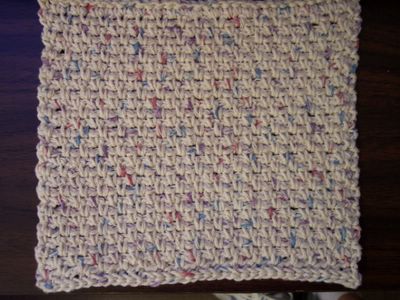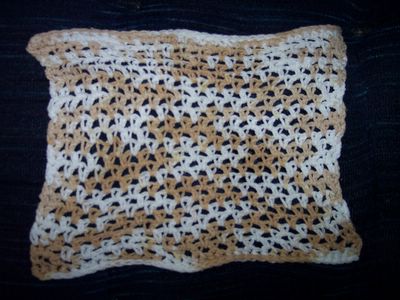Pattern: Dishcloth
People on the Crochet Partners list recently had a long discussion praising the superiority of crocheted and knitted dishcloths to store-bought dishcloths. So I crocheted a dishcloth.
When I used it, I experienced an unexpected sensory memory. This crocheted dishcloth felt just like the dishcloths I grew up with. I immediately made a few more so I could have a whole supply!
You shouldn't use acrylic yarns for dishcloths. The acrylic doesn't absorb very well, and it doesn't dry out well, either. Cotton yarns are much better.
I used Lily Sugar'n Cream and Bernat CottonTots. The CottonTots makes a softer fabric than the Sugar'n Cream, and I think the Sugar'n Cream makes a better dishcloth for this reason. The CottonTots would be better for clothing, though.
You can click on the pictures for a larger view.
Above is a newly made dishcloth, before going through the washing machine. 
The dishcloths in the rest of these pictures have been through the washing machine a few times and are holding up well, so far. 
The dishcloth above is made from Sugar'n Cream. It's an earlier version of the pattern given below. 

This dishcloth is made from CottonTots. Its texture is softer than the Sugar'n Cream. 

This Sugar'n Cream dishcloth is currently in use at my sink. You can see how the dishcloth expands and stretches when it's wet. This is a great trait for dishcloths, not so great for swimsuits! 
This pattern is extremely easy, excellent for a beginner. Gauge isn't important, so use whatever hook feels comfortable to you. I make my dishcloths approximately 8.5 inches square. This is easy to measure without a ruler if you have a piece of 8.5" x 11" printer paper handy, perhaps the page you've printed out your pattern on!
I like to have a row of slip stitches on both ends (top and bottom) of my dishcloth to give it a firm edge. To get a row of slip stitches at the beginning, you'll need to leave a really long tail when you start.
I also like to begin with a "foundationless" sc. This allows you to start making sc's right away without having to make a long foundation chain. Okay, so this isn't such a big deal for a little dishcloth, but this method really saves a lot of time when you're making an afghan that calls for a foundation chain of 200 stitches! A dishcloth is a good item to make to practice foundationless foundation rows.
Josi Hannon Madera has great pictures showing how to do this. Josi calls it the "Double Base Chain Stitch." This site also gives pictorial instructions for other stitches, including the Triple Base Chain Stitch (foundationless double crochet).
Basically, you'll be making a chain stitch at the base of each single crochet, then you make your next set of stitches into that chain stitch. Follow Josi's pictures while you work the foundation row below.
MESH DISHCLOTH
2-2.5 oz. worsted weight cotton yarn
I hook, or whatever size hook you prefer
Measure off 5.5 to 6 times the width of a sheet of paper (8.5") to make a long starting tail to use for slip stitches later. Tie your slip knot at that point. Be sure to work with the ball end of the yarn now, not the tail end.
Foundation Row 1: Chain 2. Insert hook into second chain from hook, yarn over and pull through one loop (ch st made); yarn over and pull through both loops (sc made). *Insert hook into the chain stitch you made, yarn over and pull through one loop (ch st made); yarn over and pull through both loops (sc made). Repeat from * until your chain is about 8.5" long and an odd number of stitches. Ch 1, turn.
Row 2: Sc in the first sc. *Ch 1, skip next sc, sc in the next sc. Repeat from * across. Sc in last sc. Ch 1, turn.
Row 3: Sc in the first sc. *Sc in the next ch-1 space, ch 1, skip next sc. Repeat from * across. Sc in last sc. Ch 1, turn.
Row 4: Sc in the first sc. *Ch 1, skip next sc, sc in the next ch-1 space. Repeat from * across. Sc in last sc. Ch 1, turn.
Repeat rows 3 and 4 until dishcloth is almost 8.5" long.
Next row: Sc in each sc and each ch-1 space across. Turn (do not ch 1).
Last row: Sl st in each sc across. Fasten off.
First row: With the long beginning tail, sl st in each sc across foundation row. Fasten off.
Weave in the two ends. Wash your dishcloth before using it. Now go wash some dishes!


